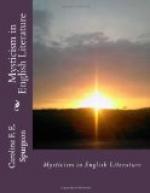To this difficulty on the side of the reader, there must in fairness be added certain undeniable limitations on the part of the seer. These are principally owing to lack of training, and possibly to lack of patience, sometimes also it would seem to defective vision. So that his symbols are at times no longer true and living, but artificial and confused.
Blake has visions, though clouded and imperfect, of the clashing of systems, the birth and death of universes, the origin and meaning of good and evil, the function and secret correspondences of spirits, of states, of emotions, of passions, and of senses, as well as of all forms in earth and sky and sea. This, and much more, he attempts to clothe in concrete forms or symbols, and if he fails at times to be explicit, it is conceivable that the fault may lie as much with our density as with his obscurity. Indeed, when we speak of Blake’s obscurity, we are uncomfortably reminded of Crabb Robinson’s naive remark when recording Blake’s admiration for Wordsworth’s Immortality Ode: “The parts ... which Blake most enjoyed were the most obscure—at all events, those which I least like and comprehend.”
Blake’s view of good and evil is the characteristically mystical one, in his case much emphasised. The really profound mystical thinker has no fear of evil, for he cannot exclude it from the one divine origin, else the world would be no longer a unity but a duality. This difficulty of “good” and “evil,” the crux of all philosophy, has been approached by mystical thinkers in various ways (such as that evil is illusion, which seems to be Browning’s view), but the boldest of them, and notably Blake and Boehme,




